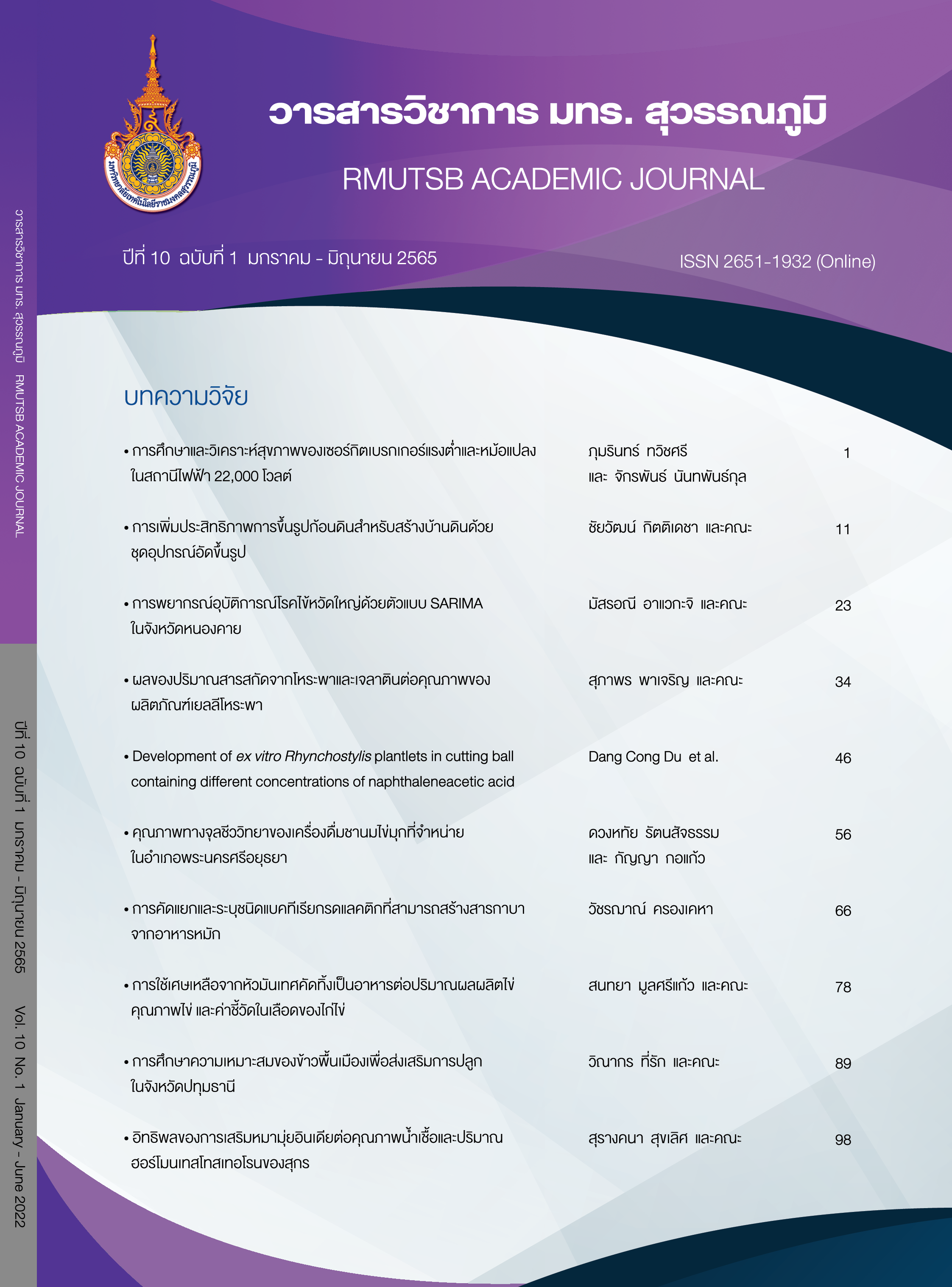Microbiological quality of bubble tea beverages sold in Phra Nakhon Si Ayutthaya district
Main Article Content
Abstract
Nowadays bubble tea is so popular beverage which widely available in department store and roadside shop. However, the production process of bubble tea has several risk points for microbial contamination. This study aimed to investigate the microbiological quality including Escherichia coli, Staphylococcus aureus, Salmonella spp., Bacillus cereus, yeast and mold in 25 samples of bubble tea beverage sold in Phra Nakhon Si Ayutthaya district. The analytical results showed that 9 samples accounting for 36% of total samples were not acceptable according to the microbiological standard by Department of Medical Sciences Announcement vol.3 (2017). E. coli and S. aureus were detected the highest followed by yeast accounting for 16, 16 and 8%, respectively. Moreover, the molds were detected within the standard and Salmonella spp. and B. cereus were not detected in all samples. Therefore, good hygiene should be realized by beverage producer to ensure safety for consumption.
Article Details

This work is licensed under a Creative Commons Attribution-NonCommercial-NoDerivatives 4.0 International License.
Published manuscript are the rights of their original owners and RMUTSB Academic Journal. The manuscript content belongs to the authors' idea, it is not the opinion of the journal's committee and not the responsibility of Rajamangala University of Technology Suvarnabhumi
References
AI-Bahry, S. N., Mahmoud, I. Y., AI-Musharafi, S. K., & Sivakumar, N. (2014). Staphylococcus aureus contamination during food preparation, processing and handling. International Journal of Chemical Engineering and Applications, 5(5), 388-392.
Argudín, M. A., Mendoza, M. C., & Rodicio, M. R. (2010). Food poisoning and Staphylococcus aureus enterotoxins. Toxins, 2, 1751-1773.
Bennett, R. W., & Lancette, G. A. (2016). Bacteriological analytical manual chapter 12: Staphylococcus aureus. Retrieved 25 February 2019, from https://www.fda.gov/Food/FoodScienceResearch/LaboratoryMethods/ucm071429.htm
Dayananda, K. R. T. L. K., Fernando, K. M. E. P., & Perera, S. (2017). Assessment of microbial contaminations in dried tea and tea brew. International Journal of Pharmaceutical Science Invention, 6(10), 6-13.
Feng, P., Weagant, S. D., Grant, M. A., & Burkhardt, W. (2019). Bacteriological analytical manual chapter 4: Enumeration of Escherichia coli and the coliform bacteria. Retrieved 25 February 2019, from https://www.fda.gov/Food/FoodScienceResearch/Laboratorymethods/ucm064948.htm
Fusco, V., Chieffi, D., Fanelli, F., Logrieco, A. F., Cho, G., Kabisch, J., Böhnlein, C., & Franz, C. M. A. P. (2020). Microbial quality and safety of milk and milk products in the 21st century. Comprehensive Reviews in Food Science and Food Safety, 19, 2013-2049.
Hampikyan, H., Bingol, E. B., Cetin, O., & Colak, H. (2017). Microbiological quality of ice and ice machines used in food establishments. Journal of water and Health, 5(3), 410-417.
Hanh, T. T. T., & Hanh, M. H. (2020). Hygienic practices and structural conditions of the food processing premises were the main drivers of microbiological quality of edible ice products in Binh Phuoc province, Vietnam 2019. Environmental Health Insights, 14, 1-9.
International Organization for Standardization (ISO). (2002). ISO 6527:2002 Microbiology of food and animal feeding stuffs-Horizontal method for the detection of Salmonella spp. Retrieved 25 February 2019, from https://www.iso.org/fr/standard/29315.html
Jongsamak, P., Charoenteeraboon, J., & Techaarpornkul, S. (2014). A microbial safety survey of edible ice at cafeterias and a weekly market of Silpakorn university, Sanamchandra palace. Thai Bulletin of Pharmaceutical Sciences, 9(1), 14-23.
Lang, W. (2012). Laboratory manual for food microbiology. Bangkok: Kasetsart University Press.
Lin, C., Yang, C., Chen, P., Liu, K., Lin, H., Lin, C., Lee, Y., Cheng, W., Wei, C., & Tsai, Y. (2019). Assessment of microbiological and chemical quality of bubble tea beverages vended in Taiwan. Journal of Food Protection, 82(8), 1384-1389.
Mahato, D. K., Lee, K. E., Kamle, M., Devi, S., Dewangan, K. N., Kumar, P., & Kang, S. G. (2019). Aflatoxins in food and feed: An overview on prevalence, detection and control strategies. Frontiers in Microbiology, 10, 1-10.
Ministry of Public Health. Department of Medical Sciences. (2017). The microbiological quality of foods and tableware vol. 3. Bangkok: P2 Design & Print.
Nguyen, Y., & Sperandio, V. (2012). Enterohemorrhagic E. coli (EHEC) pathogenesis. Frontiers in Cellular and Infection Microbiology, 2(90), 1-7.
Somtrakoon, K., Phoobantad, C., Saengsuriya, S., Kaiyawat, U., & Maneerat, S. (2018). Microbiological quality of milk-shaked drinks in unsealed containers sold in market fair, roadside and stall around Mahasarakham University. RMUTP Research Journal, 12(1), 14-26.
Tallent, S. M., Rhodehamel, E. J., Harmon, S. M., & Bennett, R. W. (2012). Bacteriological analytical manual chapter 14: Bacillus cereus. Retrieved 25 February 2019, from https://www.fda.gov/Food/FoodScienceResearch/LaboratoryMethods/ucm070875.htm
Tournas, V., Stack, M. E., Mislives, P. B., Koch, H. A., & Bandler, R. (2017). Bacteriological analytical manual chapter 18: Yeast, molds and mycotoxins. Retrieved 26 February 2019, From https://www.fda.gov/Food/FoodScienceResaerch/LaboratoryMethods/ucm071435.htm
Yimtoe, S. (2015). Food microbiological. Bangkok: Triple Education.


